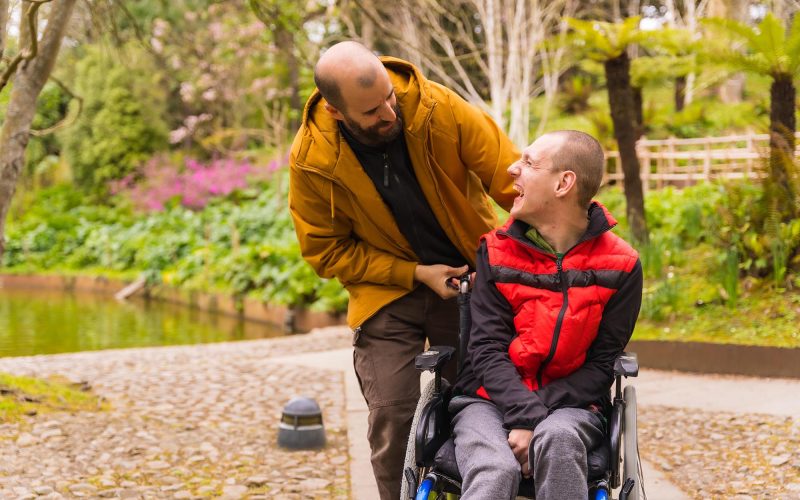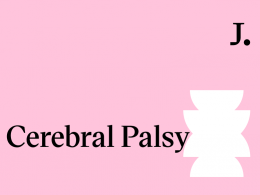Cerebral palsy is often thought of as a single disorder, but the Centers for Disease Control and Prevention (CDC) defines cerebral palsy as “a group of disorders that affect a person’s ability to move and maintain balance and posture.” Each type of cerebral palsy has a unique effect on the brain, the body, and the way the affected individual is able to navigate the world.
Cerebral palsy is non-degenerative, so symptoms do not get worse over time and in fact, frequently show great improvement. Many children with cerebral palsy are bright, intelligent children who will go on to live productive, quality lives, especially with the right family and educational support.

Causes and Risk Factors of Cerebral Palsy
Cerebral palsy can be caused by one of two things:
- Improper development of the brain (congenital)
- An injury to the brain while it is still developing (acquired)
Congenital Cerebral Palsy
The word “congenital” in English comes from the Latin word congenitus, which means “born or produced together.” A congenital condition is one that is present from birth, having developed in the womb. Eighty-five to 90 percent of cerebral palsy cases are caused by congenital factors, such as:
- Prematurity: A baby born before 37 weeks gestation is considered premature. The earlier a preterm infant is born, the greater the risk of cerebral palsy, especially for those born before 28 weeks.
- Twins: Since twins share a placenta, what happens to one often happens to the other. When one twin develops cerebral palsy in the womb, the other twin becomes 15 times more likely to develop it as well.
- Certain medical conditions in the mother: Infections during pregnancy or certain seizure conditions in the mother may increase the risk of an infant being born with cerebral palsy.
- Disrupted oxygen supply during birth: When the brain is deprived of oxygen, brain injuries can result. A lack of oxygen supply to the fragile brain of an infant during birth can cause cerebral palsy.
- Certain fertility treatments: The risk of cerebral palsy nearly doubles for single children (i.e., not twins) conceived with assistive reproductive technology, or ART.
- Untreated jaundice: Babies who are born with jaundice, a condition caused by too much of a pigment called bilirubin and marked by yellowing of the eyes and skin, should be treated for it promptly. Otherwise, there is a chance that it could develop into kernicterus, which is a type of brain damage that can lead to cerebral palsy.
Acquired Cerebral Palsy
Acquired cerebral palsy is much more rare than the congenital type, accounting for just 10-15 percent of cases. A child can develop cerebral palsy in the early stages of life in the following way, namely in the first few months or years while their brains are at their most vulnerable:
- Brain injuries or trauma: Developmentally, the first few months of life are some of the most important. Brain injuries at this stage can have severe consequences, and an injury to the movement center of the brain could lead to cerebral palsy.
- Meningitis: Meningitis is an inflammation of the fluid surrounding the spinal cord and the brain, and it can be life-threatening. Meningitis may lead to cerebral palsy if it is contracted while the brain is still developing.

Types of Cerebral Palsy
As previously mentioned, the term “cerebral palsy” encompasses a group of movement disorders with similar but different symptoms. There are four main types of cerebral palsy. Each one results from a different part of the brain being damaged or underdeveloped.
Spastic Cerebral Palsy
Spastic cerebral palsy is the most common type, accounting for anywhere from 61 to 76.9 percent of cases. It is characterized by an increase in muscle tone, which causes muscle stiffness and spasms in the limbs, often resulting in difficulty moving and walking.
Spastic cerebral palsy stems from damage to the brain’s motor cortex, which lies within the cerebral cortex and is responsible for coordinating voluntary motor functions. When the motor cortex sustains damage during early development, the ability to execute voluntary movements (such as moving one’s legs to walk) is compromised. Someone with spastic cerebral palsy most likely has one of these main subtypes:
- Spastic diplegia, which affects both legs.
- Spastic hemiplegia, which affects one side of the body.
- Spastic quadriplegia, which affects all four limbs and potentially the face.
- Monoplegia, which is very rare and only affects one limb.
Athetoid/Dyskinetic Cerebral Palsy
Athetoid cerebral palsy, also called dyskinetic cerebral palsy, results from damage to parts of the brain called the basal ganglia. They are a cluster of structures found at the base of the cerebrum, or the front part of the brain. The basal ganglia are responsible for motor control, emotional regulation, and executive functioning.
Athetoid cerebral palsy is characterized by involuntary movements, which may occur in conjunction with one another and can be categorized into three types:
- Dystonia: Slow, repetitive involuntary movements caused by sustained muscle contractions. Dystonic movements may cause cramping or put a person in an uncomfortable position that they are unable to change at will.
- Athetosis: A “writhing” movement, often in the hands or feet. The fingers and/or toes may slowly contract and twist into an uncomfortable shape.
- Chorea: Causes sudden, jerky movements. Unlike the other two main types of dyskinetic movement, chorea does not result in a sustained posture.
Ataxic Cerebral Palsy
Ataxic cerebral palsy is caused by damage to the cerebellum, which is located at the back of the brain next to the brain stem. It is often referred to as the “little brain” and is critical for making postural adjustments in order to maintain balance. When the cerebellum is damaged, the brain has trouble making those tiny adjustments that most people do not think about. For example, if a person is reaching for their coffee cup and notices that they are reaching too far to the left, they will adjust to the right as they reach out to grab it.
Ataxic cerebral palsy can lead to “overcorrection.” If a person with ataxic cerebral palsy notices that they were reaching too far to the left for a cup, their brain may overcorrect and cause a jerky movement to the right, knocking over the cup.
Mixed Cerebral Palsy
Approximately five percent of cerebral palsy cases are considered “mixed.” This happens when multiple parts of the brain are damaged, resulting in a combination of one of the above types of cerebral palsy.
Other Effects of Cerebral Palsy
Cerebral palsy does not solely affect the limbs and movement. This condition has a wide range of effects on the body and cognition, and most of them will depend on the severity of the case and which part of the brain was damaged.
Disorders that are commonly associated with cerebral palsy include:
- Seizure disorders, such as epilepsy
- Speech and language delays
- Difficulty eating and swallowing
- Gastrointestinal problems, such as gastroesophageal reflux disease (GERD)
- Vision impairment
- Hearing loss
It is important to note that trouble with speech and language alone does not necessarily indicate a cognitive delay or impairment. The majority of people with cerebral palsy have language comprehension and understand the world around them, but may be unable to respond. This can be extremely frustrating, and some people find augmentative and alternative communication (AAC) devices helpful to express themselves.
Cerebral Palsy Symptoms
Most children with cerebral palsy are diagnosed at or before the age of three, and some types may not become obvious until a child attempts to start walking. Keeping a close eye on your child’s movement, speech, and developmental milestones may help you and your child’s doctor catch cerebral palsy symptoms early.

Physical & Movement Symptoms
- Stiff, heavy, or floppy limbs
- Uncontrollable or repetitive movements
- Child appears uncomfortable or “stuck” in an awkward position
- Excessive drooling or trouble swallowing
- Tremors or shaking
- Sustained tightening of muscles, such as curled fingers or bent arms
- Delays and difficulty walking or balancing
- More or less control on one side of the body
- Lack of fine motor skills
- Slurred, hoarse, or nasally voice
- Abnormal pitch and rhythm when speaking
Neurological Symptoms
- Failure to meet developmental milestones such as walking, talking, and eating solid food
- Low responsiveness to touch stimuli
- Seizures
- Cognitive delays or learning disabilities
Diagnosing Cerebral Palsy
Unlike many conditions, cerebral palsy cannot be diagnosed in utero. If you or your child’s doctor notes symptoms consistent with cerebral palsy, the next step is to go through a diagnostic assessment.
Medical History
The first step in a diagnostic assessment for cerebral palsy is to collect a detailed medical history. A doctor will look for risk factors in the medical history to help determine the likelihood of cerebral palsy.
Physical Exam
Physical exams for cerebral palsy, particularly in infants, involve carefully checking the muscle tone in a child’s limbs and watching for movements that appear to be uncontrolled. A doctor may perform a physical exam shortly after birth if there are known risk factors present, such as a difficult birth or a known seizure disorder in the biological mother.
For children who are already walking, a physical exam may also include a gait analysis, during which a doctor observes a child’s movements and looks for abnormalities such as a drop foot, bowed legs, or a “crouch gait.” Normal gaits use both feet equally and have four steps: stance, push-off, swing, and heel strike. Deviation from this pattern may indicate spasticity in the legs.
Imaging
Additional testing may be required to confirm a cerebral palsy diagnosis. Imaging scans such as an X-ray, CT scan, or MRI allow doctors to physically see which parts of the brain, if any, are damaged. Not only are these images useful for confirming a cerebral palsy diagnosis, but they may also help a doctor narrow down the specific type of cerebral palsy that someone has based on the location of the brain damage.
Can People with Cerebral Palsy Live a Normal Life?
Though any movement disorder comes with challenges and limitations, many people with cerebral palsy can and do live relatively normal lives. They can go to school, form social connections, and hold jobs. Depending on how much assistance a person needs and what type, they may even be able to live independently.
Some people with cerebral palsy receive home healthcare or have someone help them with tasks such as grocery shopping or transportation. Others, particularly those with more severe cognitive impairments, may need more assistance, and living independently may not be an option. It depends on the person, the type of cerebral palsy they have, and what assistance and support is available to them.

Cerebral Palsy Treatment
At this time, there is no known cure for cerebral palsy though there are great strides happening in cerebral palsy research and treatment every day. Currently, there are many types of treatment available that may help improve the quality of life for those living with the condition. Many people receive a combination of these treatments in order to help them live the best life possible.
Physical Therapy
Physical therapy is one of the most common treatments for cerebral palsy and typically starts shortly after diagnosis when the child is very young. For the first one to three years, physical therapy is primarily focused on developing the child’s range of movement and helping them strengthen muscles and learn motor skills. After that, physical therapy may be targeted more toward specific practical applications like reaching and grasping a cup, for example. A physical therapist usually develops a customized exercise program to work on both general and specific issues.
Speech Therapy
Some children with cerebral palsy slur their speech or have difficulty moving their jaw, lips, and tongue. Speech therapy focuses on improving speech and communication skills and strengthening the muscles needed for clear speech. A speech-language pathologist may also be able to provide alternative communication methods, such as AAC devices, and teach children and families how to use them.
Occupational Therapy
Occupational therapy focuses on skills necessary for independent living, school, and work. These skills can range from eating, bathing, and brushing teeth to gripping a pencil or opening doors.
Recreational Therapy
Sports and play do more than entertain kids, they can also strengthen motor skills and coordination in a fun environment. Horseback riding and aquatic therapy are a few examples of recreational therapy for cerebral palsy.
Medication
Medication may be used to help manage the symptoms of cerebral palsy. Some commonly used medications include muscle relaxants or injections to help reduce tightness in specific muscles.
Surgery
Some children with cerebral palsy may need orthopedic surgery to correct limb positioning and improve mobility. There is also a procedure known as selective dorsal rhizotomy, which is typically reserved for cases that do not respond to other treatments. It involves severing certain nerves in order to relieve spasticity and pain in certain body parts like hands or feet but may result in permanent numbness in those parts.
One of the most advanced and promising surgeries for cerebral palsy is deep brain stimulation (DBS). It involves implanting an electronic device on the brain which sends electrical pulses to help reduce muscle tremors and seizures.
Mental Health Treatment
Living with a disability can be frustrating and isolating. Access to appropriate mental health treatment is important for children and adults living with cerebral palsy. Whether that means music therapy, talk therapy, or some other form of mental health care, taking care of the mind is just as important as taking care of the body.
Cerebral Palsy Parent Support Groups and Resources
Navigating a cerebral palsy diagnosis can at first feel confusing and overwhelming. However, you are not alone. There are many support groups and nonprofits that exist to help families better understand treatment options and available resources to help their child flourish.
The following groups are dedicated to advancing cerebral palsy research and providing families with help, guidance, and peer support:
- Cerebral Palsy Forum: An online message forum dedicated to sharing cerebral palsy resources and tips
- Mommies of Miracles: An online support group dedicated to connecting and supporting mothers of children with medical conditions, like cerebral palsy
- Cerebral Palsy Foundation: A nonprofit that advocates for federal funding for those with cerebral palsy as well as advancements in cerebral palsy research
- United Cerebral Palsy: In addition to hosting cerebral palsy parent support groups throughout the country, this nonprofit also provides resources on everything from cerebral palsy treatment to transportation and medical insurance
Cerebral Palsy and Birth Injury
Birth injuries or complications during birth can change a family forever. An infant who was perfectly healthy in utero may develop cerebral palsy due to an avoidable injury during their birth, and at times, these injuries may be caused by medical malpractice or negligence. Improper use of forceps during birth is just one example of a medical mistake that may result in cerebral palsy. Forceps are scissor-like instruments, flat on the ends rather than sharp, that are sometimes used to assist in delivering a baby during a difficult birth. If used improperly, they can cause permanent damage to a baby’s brain.
If you suspect that medical malpractice or negligence caused your child’s cerebral palsy, Justpoint is here to help you seek justice. Fill out a free case evaluation form today to learn more about your options. We can connect you with a cerebral palsy lawyer who can review the circumstances of your case to see if medical negligence may have contributed to your child’s cerebral palsy diagnosis.











